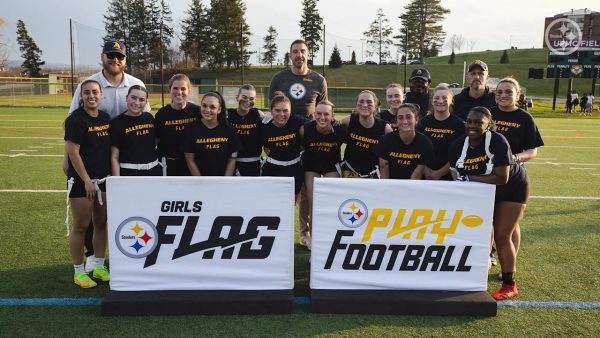2018 ES course to propose Fifth Ward changes
Professor and Chair of Environmental Science Eric Pallant will attempt to make a difference in the Meadville community with his junior seminar this fall.
The seminar, titled “Raising Fifth Ward,” is comprised of 11 junior environmental science majors who will work with Pallant on a project to help the city renovate nearly two dozen vacant lot properties in the Fifth Ward neighborhood, an area severely damaged by flooding over the past several years. At the end of the semester, the seminar will present their project to the Meadville City Council and Crawford County Planners, as well as the city manager and assistant city manager.
“We’re not the first city to deal with vacant lots,” Pallant said. “And so what we will do as a junior seminar is see what the best ideas are and best practices are from other places that tried to come to some solution, and see what might fit here.”
However, it is never quite that simple, according to Pallant, as there are many obstacles that make the Fifth Ward neighborhood — and the project — particularly vulnerable.
“We may be the only city that’s trying to do (the project) in a flood zone,” Pallant said. “It is always going to flood because of its location.”
The Fifth Ward neighborhood is also the lowest income section of Meadville. There is little incentive to build new houses there, and, “even if you wanted to, who would want to build in a place that floods every year?” Pallant said.
But the project’s “biggest struggle,” Pallant continued, “is that there’s no money. (The project) can’t really cost anything to invest (in).”
Pallant said the project has to financially balance its two goals of saving the city money while also improving quality of life for the residents of Fifth Ward. The seminar hopes to maximize efforts behind both goals without favoring one over the other, in order for the project to embody the three legs of sustainability: economy, environment and equity.
Not only is the project a risk, but it is one with an unclear timeline, Pallant said.
“Usually I start these and I have some sense of what might happen. Not making a decision is a decision, and I’m counting on these juniors to figure it out,” Pallant said.
Cam Neiblum, ’20, a student in Pallant’s seminar, expressed similar uncertainty and ambition for the project.
“I definitely feel … that it’s big,” Neiblum said. “It is going to be a lot. I have no idea where it could even begin. … and I’m pretty sure that’s how the class feels.”

Despite the odds being stacked against them, Neiblum explained that optimism about the project is important to her, and she believes that the class’ goals can be accomplished. She also said that the skills she would get out of the project would equip her for her future career — using environmental science to help people achieve their visions for their own neighborhoods.
“It’s possible. I definitely think it’s possible,” Neiblum said. “What I want to focus on in my future is actually something very similar to this (skill) of taking an environment, taking an area, and changing it to make other people in that environment happy; obviously that’s what everyone wants to be, is happy, especially in their own neighborhood.”
Another student from the seminar, Maura McCampbell, ’20, finds the daunting nature of the project exhilarating.
“It’s exciting,” McCampbell said. “Like the prospects … I find them to be incredibly stimulating, because, it’s what in environmental science we’d call a ‘wicked hard problem,’ a problem that’s incredibly complicated, that doesn’t have a clear solution, that can’t be neatly packaged and tied up and creased and folded into a box.”
Sharing Neiblum’s belief in working toward others’ visions and not merely one’s own, McCampbell offered a word of advice for her peers:
“(We need to be) making sure that we’re not imposing our notion of quality of life onto the residents that are living in the Fifth Ward,” McCampbell said. “Something I’m incredibly invested in is making sure that this a project that the community is behind.”
In the coming weeks, the students will be doing research individually on solutions that have worked in similar situations across the globe. They will then be combining their findings into a master plan that they can easily present. To make sure their final proposal is feasible, students will be working with Bennett Gould, ’17, a stormwater program support manager and GIS technician for the city.
“I guess I see myself as the point person throughout the junior seminar’s process between the city and the class, in terms of being that resource of the city that can help answer questions and provide guidance and insight anywhere it might be necessary,” Gould said.
For Gould, the extremely challenging nature of projects like this one is not a downside of his work with the City of Meadville, but in fact the very reason he loves what he does.
“It really excites me in that environmental problems like the ones they’re addressing never have clear answers,” Gould said. “They’re always very multifaceted, and have a lot of intricacy to them, and that presents a real challenge that requires creative thinking and, ultimately, you can have amazing outcomes with them.”
Looking back on his time spent as an environmental science major at Allegheny, Gould said that several aspects of Pallant’s project reflect the college’s core values of community engagement and critical thinking, two values he believes are integral to the proposal’s success.
“(The juniors) need to do what Allegheny students do very well — weeding through the details and figuring out what solution is best for the specific site,” Gould said.
For now, Pallant’s juniors are keeping in line with Gould’s optimism and are working hard to find the right combination to fix this “wicked hard problem.”








